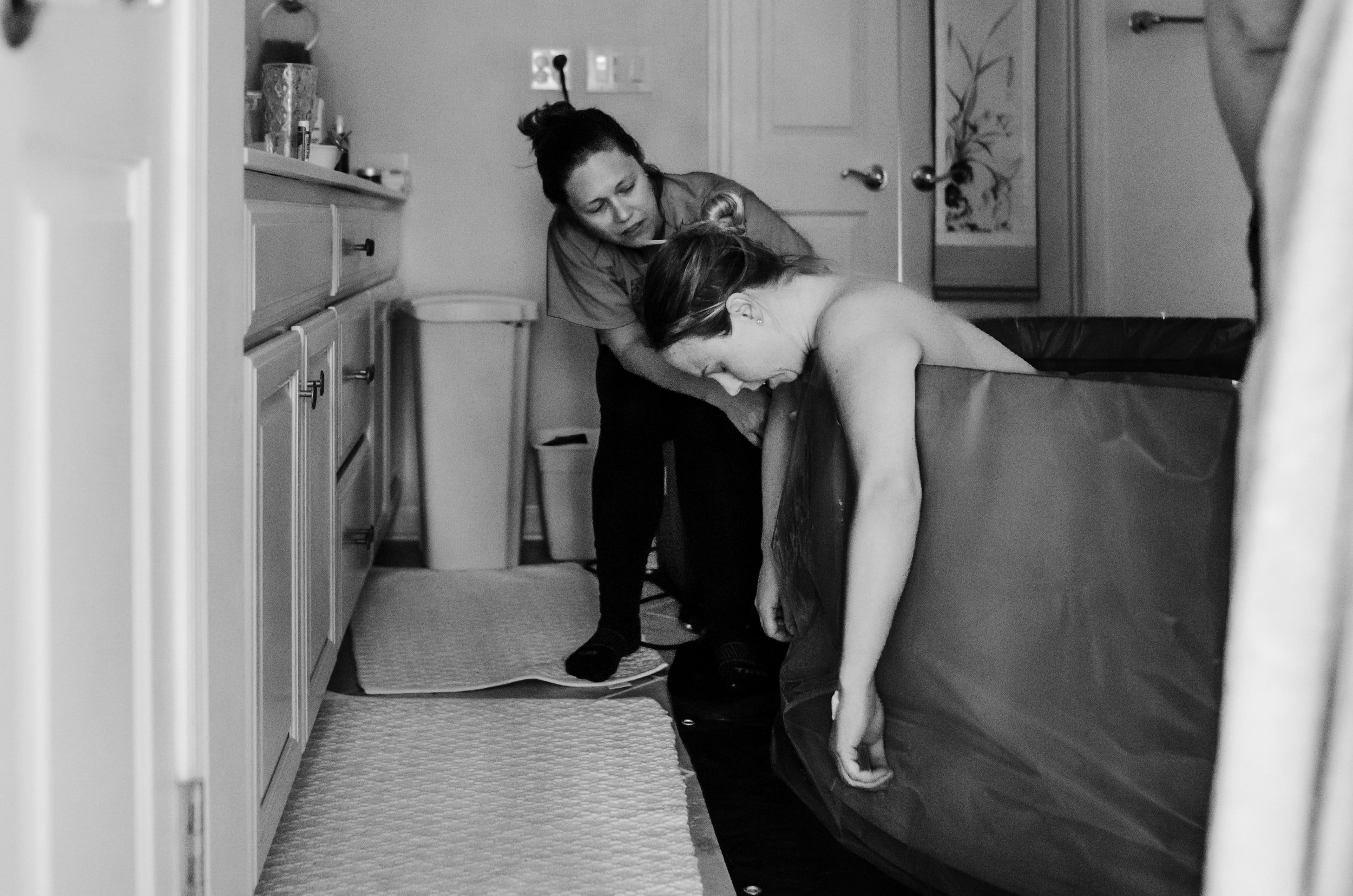Packing Advice For Your Hospital Stay
with Key Points to Ensure You Get the Best Birth Support
by TBBN President, Cynthya Dzialo
Not only am I a board volunteer and blog editor for Tampa Bay Birth Network, but I’m the founder and owner of The Happiest Doulas which serves the communities of both Tampa Bay and metro Atlanta. Over the span of 15 years in business and thousands of birthdays celebrated, our team of doulas and educators has compiled a list of suggested items to enhance our clients’ labor and birth experience in a hospital setting. Many items from the below list were included based on client feedback as well as what we know to ease labor and birth. You certainly don't need to pack every item listed - pick and choose what suits you and your family’s needs.
The Happiest Doulas highly encourage clients to purchase an inflatable exercise/balance ball for home use during pregnancy and labor. When in labor, we suggest bringing the inflated ball into the hospital so they can use it upon arrival. Purchasing a fabric cover with a handle will make it easier to carry everything you need for labor. I’ve seen fabric ball covers on sale at Etsy.com - even custom covers can be ordered, which can be a useful marketing tool for doulas and other perinatal businesses.
Prior to Covid-19, our recommendation was to pack three small bags - a labor tool bag, a diaper/baby bag, and another for the postpartum stay in order to reduce the clutter in the labor room. Due to current pandemic restrictions at many hospitals, visitors and patients may not be able to move freely or leave their rooms, so be sure to pack your essentials and bring with you everything from the car when you first arrive at the hospital.
Labor Tool Bag
Battery operated LED candles (get at least 3 pillars or a 12 pack of tea lights)
One string of Christmas lights (25 bulbs are enough, any color)
Music (create multiple playlists; soothing, upbeat, chanting, and nature sounds)
Bluetooth speaker synced to your phone
Phone with earbuds (to wear in the car and during an initial assessment at the hospital)
Essential oils (lavender, lemon, peppermint, etc.) and a diffuser
Massage oil (olive oil or a packaged labor massage type)
Massage tools (Nukkles, tennis balls, etc.)
Inflated birth ball with cover (for easy handling)
Small black combs (to hold in your hands and stimulate pressure points that release endorphins)
Hairbands, ponytail holders, and/or a shower cap
Chapstick (get a 3 pack and put one in labor bag and another for both you and your partner's pocket!)
Essential toiletries (pack light; toothbrushes/paste, contacts/solution)
Sea-Band for wrist acupressure to relieve nausea
Large heating pad
Microwavable rice sock (for home use and the car ride)
Easily digestible snacks (fruit, applesauce, crackers, pudding, honey sticks, lollipops)
Sundress (something old from your closet) to wear at home in labor and at the hospital if you want to avoid a pre-worn patient gown
Flip-flops or slippers (for both of you, may get messy)
Swim trunks (for partner)
Camera, batteries, memory cards, and phone chargers
Extra pillows (may get messy)
Disposable Styrofoam cooler or 2 large Ziploc baggies (for double-bagging the placenta, if saving or encapsulating)
Cord/Tissue Blood Kit (if collecting)
Extra-long phone and laptop chargers - IMPORTANT!
Postpartum Bag
Nursing tanks or maternity bras (be sure they fit correctly!)
PJs or a nightgown
Socks
Slippers
Bathrobe
Cotton "Granny" panties - ones that are high enough not to irritate a possible c-section scar. While in the hospital, you can use the provided mesh-type panties
Toiletries
Perineal spray
Nipple Butter (please don't use Lanolin, which can easily irritate!)
Snacks
Baby book
Music/laptop/books/camera
Baby (Diaper) Bag
Going-home outfit with a blanket
Newborn mitts (or use socks)
Socks
Hats
Onesies or gowns
Cloth diapers, wipes, and balm (if using your own)
Nursing pillow
Car seat (must have before driving home)
Do you have recommendations to add to this list? If so, please share these with us! You can tell your suggestion and reasons for it by sharing a photo of the item and commenting on IG. Don’t forget to tag us @tampabaybirthnetwork.
Tips for Traveling to the Hospital While in Labor
Empty your bladder before you leave home.
We suggest folding an old towel or two to sit on in the car for the ride to the hospital. Do this whether or not your bag of waters has ruptured. You don’t have to bring the towel(s) into the hospital.
For pain relief, use an ice pack or a warm rice sock on your lower back. Leave the ice pack behind unless you’re also bringing a cooler to fill with ice for later use after you’re admitted to the hospital.
Bring a receptacle to collect any vomit. People often get nauseous on the car ride. Note: sugar also can cause nausea so be sure to dilute juice, etc. before drinking. (Watch what you eat too.) This is a good time to use Sea-Bands or your thumb to apply pressure on the underside of the wrist.
Keep an apple juice box in the car so you can drink it on the way to the hospital. Add the juice to your chilled water bottle. Drink a quarter to a third of it on the ride and then continue to sip on it during triage and fetal monitoring. Coldwater and juice (sugar) get your baby very active for heart monitoring and this allows for a good "strip," which is mandatory for 20-30 minutes in triage and once admitted to labor and delivery.
You can sit on the birth ball during this time or stand and lean over it while rocking your hips. Do what’s most comfortable for you during this time! It isn't necessary for you to lie flat on your back in bed except for when you may have consented to a vaginal/cervical exam but some midwives will perform an exam while you’re on hands and knees - so just ask! You don’t always have to get an exam - find out when and why it may be necessary - you’re in charge of your body and should always be asked for permission before any procedure or medication is delivered.
To learn how to avoid other routine hospital procedures unless they’re medically necessary, check out this post by The Happiest Doulas.
Ensure Your Freedom of Movement
One key element to having an easier, faster, and more productive labor is movement. In the past, women were drugged and laid out flat on their backs to give birth and given very little opportunity to move around during labor. To this day, even a lot of media still portrays birth as a "lay on your back and push" method.
Movement during labor optimizes the baby's positioning by using gravity to help engage the baby into the pelvis, naturally move the baby down the birth canal, and can help relieve pain. It can also decrease the amount of intervention needed to help labor progress. Depending on your medical condition, fetal monitoring may be required intermittently or continuously during labor. Some hospitals have wireless fetal monitors that allow you to still walk around without restricting movement. Be sure to discuss these options with your midwife and doctor prior to labor and include your preferences on your hospital birth plan.
The more relaxed and mobile you can be during labor, the easier it will be!
Follow these 3 major points to get your needs met:
Your choice of a care provider is important. Be sure to choose someone with a natural mindset that supports movement in labor.
If it’s your first labor, consider staying at home until you're in active labor (6cm). Contractions that come every 4 minutes - each lasting for about 1 minute in length - for 1 steady hour is a good indicator that you’ll be approaching the active phase soon. This is the “4-1-1 guide” to prepare your team (typically, there’s more time available to still labor at home) to be ready to leave for your birth facility. Laboring at home is more relaxing than being at the hospital because you're in your own environment and there’s less risk of infection too.
Prepare for labor and birth by taking an individualized childbirth class, reading evidence-based materials, and creating a bubble of peace around yourself. Learn what to expect for hospital childbirth, gain tools for staying comfortable throughout the process, and build a support team to help you achieve your goals. Hire a birth doula or have a friend or family member join you during labor to help you with positioning techniques and other comfort measures.
To gain more tips to Make Labor Productive with Positivity, Positions, and Personal Support, visit The Happiest Doulas’ blog post at https://www.happiestdoulas.com/doulasupport/healthy-birth-practice-2.
After all, you’ll always remember the day you gave birth and how you felt or were made to feel during the experience. Best wishes for a wonderful, safe, and loving Birthday.
Contributed by Cynthya Dzialo, founder and owner of The Happiest Doulas. She holds certification with Hypnobabies as a Hypno-Doula and as a labor doula with Childbirth International for 15 years. She is a birth doula, lactation counselor, and childbirth educator, and part of the TBBN community as our volunteer President and blog editor.



